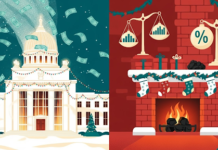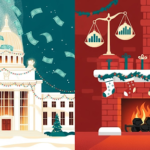What’s Holding Back Wall Street Bulls?
It’s a strange week when Wall Street’s optimism feels…cautious. With a projected S&P 500 rise of 9% by 2025, you’d think the mood would be euphoric. Yet, the consensus seems oddly restrained, like runners pacing themselves too conservatively in a race where the finish line might just be closer than expected.
Mizuho Securities hints that projected earnings growth could outshine even these modest predictions, signaling that the market may still underestimate its potential. But there are real risks: inflation lurking as a potential disruptor, interest rates precariously balanced, and the U.S. labor market operating at full throttle.
This week’s issue will explore whether this conservative forecast is the right call or a symptom of market complacency. Get ready to face this sentiment tug-of-war—there’s more than meets the eye in today’s market pulse.
This Week I Learned…
How Inflation Can Be a Double-Edged Sword
Inflation often feels like the market’s villain, eroding the purchasing power of your dollars and rattling investor confidence. But did you know that specific sectors thrive in inflationary environments?
Historically, commodities, real estate, and certain equities like consumer staples and utilities have outperformed when inflation ticks upward. Why? Commodities like oil and gold mirror price increases, while real estate benefits from rising property values and rents.
Even tech isn’t left out. Companies with dominant market positions and pricing power—think “essential services”—can pass on costs to consumers, shielding their margins. Meanwhile, bonds often falter in high-inflation environments due to fixed interest payments that lose value over time.
The next time inflation rears its head, it doesn’t have to spell doom for your portfolio. You could turn inflation into an ally rather than an adversary with the right mix of assets.
The Fun Corner
Why the Fear Gauge Needs a PR Makeover
The CBOE Volatility Index (VIX), fondly dubbed the “fear gauge,” often grabs headlines during market turbulence. But here’s the kicker: a rising VIX doesn’t always mean bad news.
Here is an example: The VIX climbs, and investors panic. But it’s often a sign that traders are simply hedging against uncertainty—not that doom is on the doorstep. Sometimes, a high VIX can signal opportunity as overstated fears cool off.
As market lore goes, “Buy when there’s blood in the streets.” Maybe it’s time to add, “Check the VIX before you panic.”
The Risks of Playing It Too Safe
Wall Street’s consensus for a 9% rise in the S&P 500 by 2025 might look optimistic, but dig deeper, and it feels…underwhelming. Analysts, including those at Mizuho Securities, acknowledge that earnings growth could exceed forecasts, yet there’s hesitation to call for a bull market on steroids. Why the restraint?
One word: risk. The market has consistently outpaced earnings growth in recent years, and with inflationary pressures looming, the possibility of rate adjustments by the Fed adds uncertainty. If rates rise too quickly, borrowing costs soar, potentially dragging down equities.
Moreover, an overheated labor market could exacerbate domestic inflation, particularly if growth accelerates unexpectedly. Add to that the specter of a weaker U.S. dollar amplifying global inflationary pressures, and the cautious tone begins to make sense.
But here’s the twist: The very factors keeping analysts conservative—earnings growth, stable inflation, and resilient labor markets—could drive the market higher. If inflation remains subdued and rates stabilize, price-to-earnings multiples in the 23-24 range might not look so expensive after all.
For investors, this conservative consensus could spell opportunity. Caution breeds inefficiency, and inefficiency creates openings. The question is: Are you ready to act on them?
The Last Say
Cautious Bulls and Hidden Opportunities
As Wall Street projects a steady yet conservative rise, the market’s paradox of cautious optimism offers a lesson in strategy. Being wary of inflation’s disruptive potential is wise, but opportunities abound for those ready to dig deeper.
In 2025, the tension between restraint and ambition might define the market. Investors should monitor inflation, rate decisions, and global economic shifts while staying flexible. Remember: even within cautious predictions lies the chance to outperform.
Until next week, keep your eyes on the signals—and your strategies sharp.























